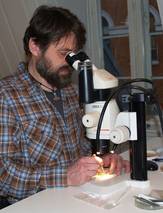Borehole samples from the mounds
By Mads Dengsø Jessen
In 2009 boreholes were made into the North and South Mounds at Jelling. From these a number of samples were taken for analysis to establish what type of turfs and earth the mounds are constructed from and which plants grew in the earth. The organic remains, which are still preserved, have been sorted and cleaned and we can now form a first impression of the vegetation in Viking Age Jelling.
The well-preserved remains of organic material from each of the samples, such as seeds, leaves and twigs, have been counted under the microscope and the results from the boreholes so far indicate a very uniform type of turf. More or less the same type of turf has been used throughout the mound, which has resulted in a very homogeneous composition. The seeds and other plant remains that are found in the turfs point toward typical heath plants, especially heather. Previously it was believed that the turfs were brought in to build the mounds from the heathlands in the surrounding area, but with the results of the analysis so far it is now thought that this was not the case. Apparently the turfs were taken straight from the area adjacent to the mounds, since the earth in the turfs was quite clayey, just like the subsoil in Jelling is. Therefore it is more likely that the turfs were dug up in the local area and not from the heath.
This gives a somewhat different picture of the landscape around Jelling than at first was imagined. Normally this fertile earth would have been cultivated as arable land, unlike the sandy heath areas, which lie further to the west. However, the composition of the turfs seems to show that around the mounds there were large open and uncultivated areas of heath, which have been cut up and placed in the mounds.
The very clayey type of turf is at the same time thought to have been the reason for the small pool of water, which was found on top of the North Mound in the past. When the burial chamber was dug down to for the first time the hole was probably only partly filled up again afterwards and then with a more mixed earth suitable for mice activity. This resulted in a small area of subsidence in the middle of the mound. This came to function as a reservoir for rainwater, as the water could not flow out and away through the mound’s clay-rich earth. This was fortunate for the fine ladies of Jelling, who quickly realised that the best water for tea making could be collected there.


